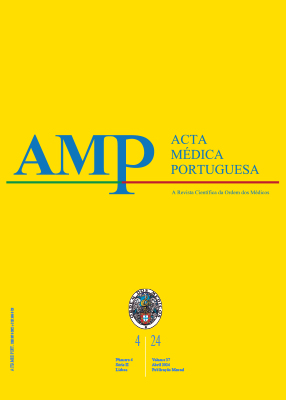Análise Mensal da Taxa de Mortalidade Infantil em Portugal durante a Pandemia de COVID-19: Perceções a partir da Monitorização Contínua
DOI:
https://doi.org/10.20344/amp.19642Palavras-chave:
COVID-19, Mortalidade Infantil, Pandemia, Portugal, Recém-NascidoResumo
Introdução: A pandemia da COVID-19 teve um impacto significativo na saúde pública mundial. A taxa de mortalidade infantil (TMI), uma estatística vital e indicador-chave da saúde geral de uma população, é essencial para o desenvolvimento de programas de prevenção eficazes no sector da saúde.
Evidências existentes indicam uma diminuição da TMI durante a pandemia da COVID-19. Realizou-se uma análise a nível nacional para calcular a TMI e descrever a sua evolução ao longo dos anos (de 2016 até 2022) usando uma análise mês a mês.
Métodos: Os dados sobre o número de óbitos com menos de um ano de idade foram obtidos do Sistema de Certificação Eletrónica de Óbitos (SICO) e os dados sobre o número de nascimentos mensais foram obtidos a partir do Instituto Nacional de Estatística. A taxa de mortalidade infantil (TMI) foi calculada por mês, considerando o número acumulado de óbitos com menos de um ano de idade e o número de nascidos vivos nos 12 meses anteriores.
Resultados: Em Portugal, a TMI diminuiu antes e durante a pandemia da COVID-19. Os valores mais baixos foram observados em setembro e outubro de 2021 (2,15 e 2,14 por 1000 nascimentos vivos, respetivamente). A TMI permaneceu abaixo do limiar de três mortes por 1000 nascimentos vivos durante o período crítico da pandemia.
Conclusão: Portugal alcançou um progresso notável na redução da sua TMI ao longo dos últimos 60 anos. O país registou os valores mais baixos de sempre da TMI durante a pandemia da COVID-19. Estudos adicionais são necessários para compreender completamente as tendências observadas.
Downloads
Referências
World Health Organization. Weekly epidemiological update on COVID-19 – 19 January 2024. [cited 2024 Feb 14]. Available from: https://www.who.int/
publications/m/item/covid-19-epidemiological-update---19-january-2024.
Gill JR, DeJoseph ME. The importance of proper death certification during the COVID-19 pandemic. JAMA. 2020;324:27-8. DOI: https://doi.org/10.1001/jama.2020.9536
World Health Organization. Infant mortality rate (between birth and 11 months per 1000 live births). [cited 2023 Jan 08]. Available from: https://www.who.
int/data/gho/indicator-metadata-registry/imr-details/1.
Reidpath DD, Allotey P. Infant mortality rate as an indicator of population health. J Epidemiol Community Health. 2003;57:344-6. DOI: https://doi.org/10.1136/jech.57.5.344
Ozdemir S, Oruç MA. Evaluation of stillbirths and infant mortality before and during the COVID-19 pandemic: a retrospective study. Postgrad Med.
;134:524-32.
United Nations International Children’s Emergency Fund. Levels and trends in child mortality - UNICEF DATA. [cited 2023 Jan 05]. Available from: https://data.unicef.org/resources/levels-and-trends-in-child-mortality/.
Khera N, Santesmasses D, Kerepesi C, Gladyshev VN. COVID-19 mortality rate in children is U-shaped. Aging. 2021;13:19954-62. DOI: https://doi.org/10.18632/aging.203442
Santana P, Almendra R. The health of the Portuguese over the last four decades. Méditerranée. 2018;130.
Nogueira PJ, de Araújo Nobre M, Nicola PJ, Furtado C, Carneiro AV. Excess mortality estimation during the COVID-19 pandemic: preliminary data from Portugal. Acta Med Port. 2020;33:376-83. DOI: https://doi.org/10.20344/amp.13928
Direção-Geral da Saúde. Vigilância de mortalidade. Mortalidade em tempo real. [cited 2023 Jan 08]. Available from: https://evm.min-saude.pt/.
Instituto Nacional de Estatística. Nados-vivos (N.o) por local de residência da mãe (NUTS - 2013), sexo e mês de nascimento. [cited 2023 Jan 08]. Available from: https://www.ine.pt/xportal/xmain?xpid=INE&xpgid=ine_indicadores&indOcorrCod=0008086&xlang=pt&contexto=bd&selTab=tab2.
Instituto Nacional de Estatística. Nados-vivos (N.o) por local de residência da mãe (NUTS - 2013) e sexo. [cited 2023 Jan 08]. Available from: https://www.ine.pt/xportal/xmain?xpid=INE&xpgid=ine_indicadores&indOcorrCod=0007286&contexto=bd&selTab=tab2.
United Nations. Handbook of vital statistics systems and methods. Volume 1, Legal, organizational and technical aspects. United Nations, New York 1991. [cited 2023 Jan 04]. Available from: https://digitallibrary.un.org/record/137198.
Driscoll AK, Ely DM. Quarterly provisional estimates for infant mortality, 2020-Quarter 2, 2022. National Center for Health Statistics, National Vital Statistics System, Vital Statistics Rapid Release Program. 2022. [cited 2023 Jan 11]. Available from: https://www.cdc.gov/nchs/nvss/vsrr/infant-mortalitydashboard.htm.
Kramer MS, Demissie K, Yang H, Platt RW, Sauvé R, Liston R. The contribution of mild and moderate preterm birth to infant mortality. JAMA. 2000;284:843-9. DOI: https://doi.org/10.1001/jama.284.7.843
Berghella V, Boelig R, Roman A, Burd J, Anderson K. Decreased incidence of preterm birth during coronavirus disease 2019 pandemic. Am J Obstet Gynecol MFM. 2020;2:100258. DOI: https://doi.org/10.1016/j.ajogmf.2020.100258
Hedermann G, Hedley PL, Bækvad-Hansen M, Hjalgrim H, Rostgaard K, Poorisrisak P. Danish premature birth rates during the COVID-19 lockdown. Arch Dis Child Fetal Neonatal Ed. 2021;106:93-5. DOI: https://doi.org/10.1136/archdischild-2020-319990
Haddadin Z, Schuster JE, Spieker AJ, Rahman H, Blozinski A, Stewart L. Acute respiratory illnesses in children in the SARS-CoV-2 pandemic: prospective multicenter study. Pediatrics. 2021;148:e2021051462. DOI: https://doi.org/10.1542/peds.2021-051462
Honeyford K, Coughlan C, Nijman RG, Expert P, Burcea G, Maconochie I. Changes in emergency department activity and the first COVID-19 lockdown: a cross-sectional study. West J Emerg Med. 2021;22:603-7. DOI: https://doi.org/10.5811/westjem.2021.2.49614
Downloads
Publicado
Como Citar
Edição
Secção
Licença
Direitos de Autor (c) 2024 Acta Médica Portuguesa

Este trabalho encontra-se publicado com a Creative Commons Atribuição-NãoComercial 4.0.
Todos os artigos publicados na AMP são de acesso aberto e cumprem os requisitos das agências de financiamento ou instituições académicas. Relativamente à utilização por terceiros a AMP rege-se pelos termos da licença Creative Commons ‘Atribuição – Uso Não-Comercial – (CC-BY-NC)’.
É da responsabilidade do autor obter permissão para reproduzir figuras, tabelas, etc., de outras publicações. Após a aceitação de um artigo, os autores serão convidados a preencher uma “Declaração de Responsabilidade Autoral e Partilha de Direitos de Autor “(http://www.actamedicaportuguesa.com/info/AMP-NormasPublicacao.pdf) e a “Declaração de Potenciais Conflitos de Interesse” (http://www.icmje.org/conflicts-of-interest) do ICMJE. Será enviado um e-mail ao autor correspondente, confirmando a receção do manuscrito.
Após a publicação, os autores ficam autorizados a disponibilizar os seus artigos em repositórios das suas instituições de origem, desde que mencionem sempre onde foram publicados e de acordo com a licença Creative Commons









